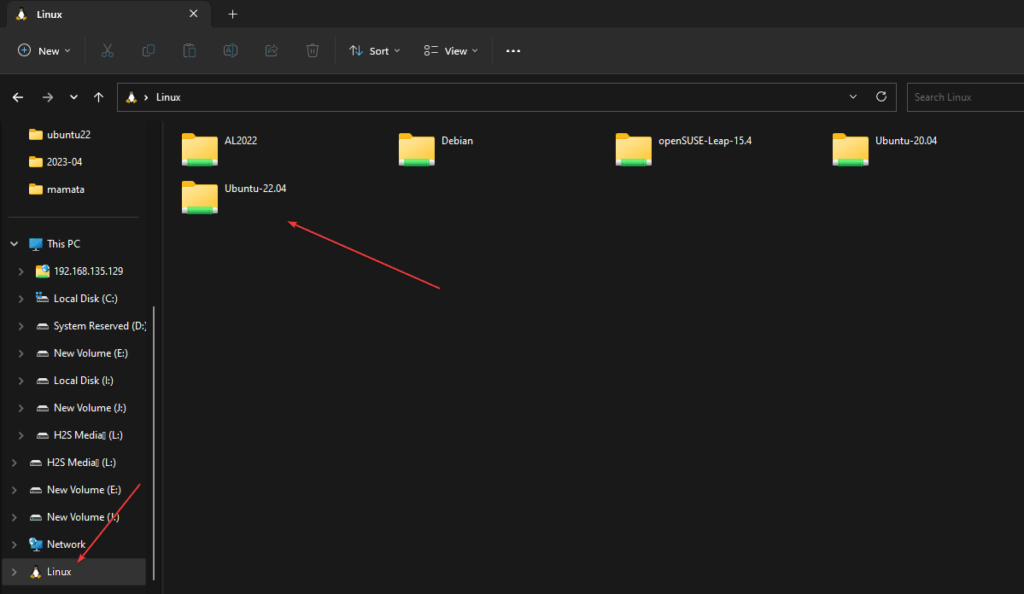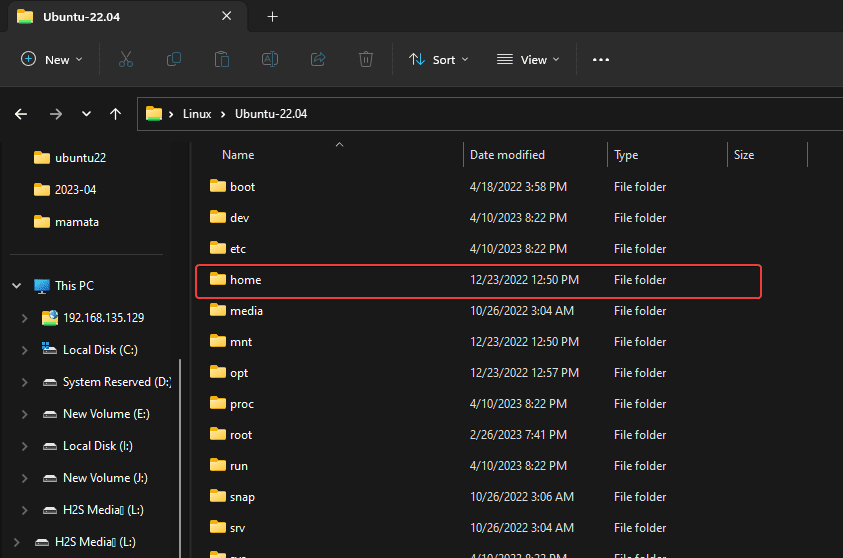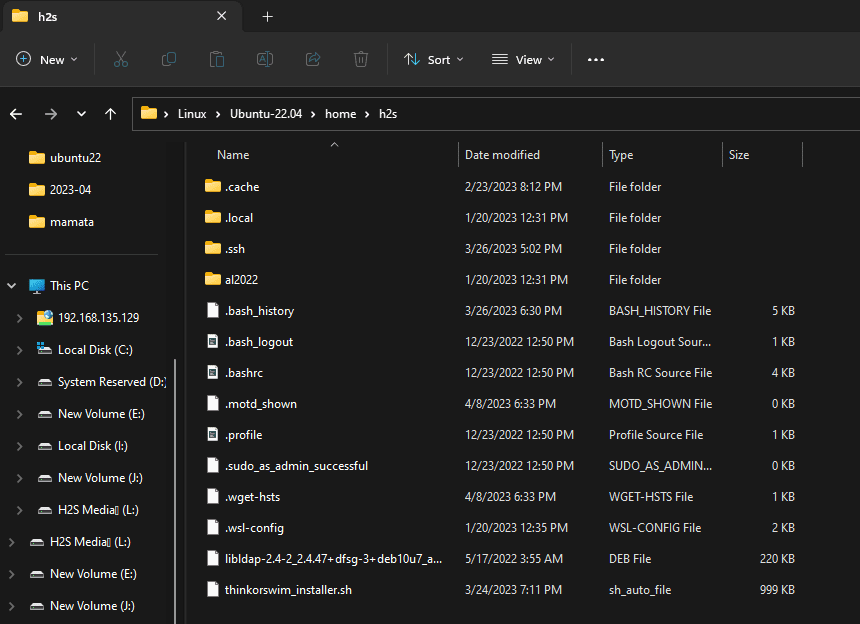How to find WSL home directory using Windows GUI?
WSL (Windows Subsystem for Linux) is a specially created software layer by Microsoft to run Linux binary executables natively on Windows 11 or 10. When you install a Linux distribution on WSL, it creates a Linux environment in Windows with its own file system and home directory. But how do I find this directory using Windows' Graphics File Explorer? If you don’t know, then in this article, we will learn about it.
The default home directory for user accounts in WSL is located at /home/
For example , if your username is H2s, the home directory in WSL will be located at /home/h2s. By default, when we launch the WSL Linux application, we are in the home directory. You can switch to this state using:
cd /home
Home directories in WSL Linux work similarly to the traditional Linux distributions we run on virtual machines, containers, or bare systems. It saves all files related to the user's personal files and configuration settings. All files in the home directory are only for the WSL instance and will not interfere with the Windows file system and vice versa...
While we show this tutorial for the Ubuntu subsystem, for other subsystems such as those installed on WSL The process is the same for OpenSUSE, Kali and Debian).
Steps to find the WSL home directory using Windows' GUI File Explorer
- On Windows 10 or 11, go to File Explorer or open MyPC directly to get it to find the WSL Linux app home folder.
- Afterwards, scroll down from the left panel to the end.
- Open WSL Linux File Explorer: There you will see the Linux penguin icon, click on it.
- Now all the installed Linux applications on WSL (like Ubuntu, Debian, Kali, etc.) will be displayed in the folder.
- For example , if we open the Ubuntu folder, then inside it we will have a directory called "home". Open it and you will find the user and other files for this WSL Linux application.

- After selecting the Linux WSL application, open the home directory that you want to browse manually using the GUI.


##Additional tips:
Access Ubuntu command terminalFor all Windows 11 or 10 system drives or other Linux environments installed on Windows WSL; we need to follow the mount command for Linux.
Note: One thing that needs to be mentioned is that the Bash Shell for Linux environments should be launched with administrative privileges to access the System Folders of Windows. To grant administrative rights, simply right-click on an installed Linux environment (such as Ubuntu) and select "Run as administrator."
In Linux Bash ShellType the following command to mount C: Drive:
cd /mnt/cls
D:Drive type
cd /mnt/dls
In this way, we can also mount internal and external drives, including network drives, connected to Windows 11 or 10 systems.
The above is the detailed content of How to find WSL home directory using Windows GUI?. For more information, please follow other related articles on the PHP Chinese website!

Hot AI Tools

Undresser.AI Undress
AI-powered app for creating realistic nude photos

AI Clothes Remover
Online AI tool for removing clothes from photos.

Undress AI Tool
Undress images for free

Clothoff.io
AI clothes remover

Video Face Swap
Swap faces in any video effortlessly with our completely free AI face swap tool!

Hot Article

Hot Tools

Notepad++7.3.1
Easy-to-use and free code editor

SublimeText3 Chinese version
Chinese version, very easy to use

Zend Studio 13.0.1
Powerful PHP integrated development environment

Dreamweaver CS6
Visual web development tools

SublimeText3 Mac version
God-level code editing software (SublimeText3)

Hot Topics
 1657
1657
 14
14
 1415
1415
 52
52
 1309
1309
 25
25
 1257
1257
 29
29
 1230
1230
 24
24
 Linux Architecture: Unveiling the 5 Basic Components
Apr 20, 2025 am 12:04 AM
Linux Architecture: Unveiling the 5 Basic Components
Apr 20, 2025 am 12:04 AM
The five basic components of the Linux system are: 1. Kernel, 2. System library, 3. System utilities, 4. Graphical user interface, 5. Applications. The kernel manages hardware resources, the system library provides precompiled functions, system utilities are used for system management, the GUI provides visual interaction, and applications use these components to implement functions.
 vscode terminal usage tutorial
Apr 15, 2025 pm 10:09 PM
vscode terminal usage tutorial
Apr 15, 2025 pm 10:09 PM
vscode built-in terminal is a development tool that allows running commands and scripts within the editor to simplify the development process. How to use vscode terminal: Open the terminal with the shortcut key (Ctrl/Cmd). Enter a command or run the script. Use hotkeys (such as Ctrl L to clear the terminal). Change the working directory (such as the cd command). Advanced features include debug mode, automatic code snippet completion, and interactive command history.
 How to check the warehouse address of git
Apr 17, 2025 pm 01:54 PM
How to check the warehouse address of git
Apr 17, 2025 pm 01:54 PM
To view the Git repository address, perform the following steps: 1. Open the command line and navigate to the repository directory; 2. Run the "git remote -v" command; 3. View the repository name in the output and its corresponding address.
 Where to write code in vscode
Apr 15, 2025 pm 09:54 PM
Where to write code in vscode
Apr 15, 2025 pm 09:54 PM
Writing code in Visual Studio Code (VSCode) is simple and easy to use. Just install VSCode, create a project, select a language, create a file, write code, save and run it. The advantages of VSCode include cross-platform, free and open source, powerful features, rich extensions, and lightweight and fast.
 vscode terminal command cannot be used
Apr 15, 2025 pm 10:03 PM
vscode terminal command cannot be used
Apr 15, 2025 pm 10:03 PM
Causes and solutions for the VS Code terminal commands not available: The necessary tools are not installed (Windows: WSL; macOS: Xcode command line tools) Path configuration is wrong (add executable files to PATH environment variables) Permission issues (run VS Code as administrator) Firewall or proxy restrictions (check settings, unrestrictions) Terminal settings are incorrect (enable use of external terminals) VS Code installation is corrupt (reinstall or update) Terminal configuration is incompatible (try different terminal types or commands) Specific environment variables are missing (set necessary environment variables)
 How to run java code in notepad
Apr 16, 2025 pm 07:39 PM
How to run java code in notepad
Apr 16, 2025 pm 07:39 PM
Although Notepad cannot run Java code directly, it can be achieved by using other tools: using the command line compiler (javac) to generate a bytecode file (filename.class). Use the Java interpreter (java) to interpret bytecode, execute the code, and output the result.
 How to run sublime after writing the code
Apr 16, 2025 am 08:51 AM
How to run sublime after writing the code
Apr 16, 2025 am 08:51 AM
There are six ways to run code in Sublime: through hotkeys, menus, build systems, command lines, set default build systems, and custom build commands, and run individual files/projects by right-clicking on projects/files. The build system availability depends on the installation of Sublime Text.
 vscode Previous Next Shortcut Key
Apr 15, 2025 pm 10:51 PM
vscode Previous Next Shortcut Key
Apr 15, 2025 pm 10:51 PM
VS Code One-step/Next step shortcut key usage: One-step (backward): Windows/Linux: Ctrl ←; macOS: Cmd ←Next step (forward): Windows/Linux: Ctrl →; macOS: Cmd →



